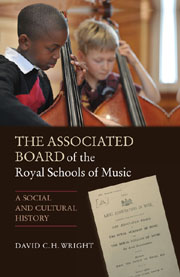Book contents
- Frontmatter
- Contents
- List of Illustrations
- List of Tables
- Dedication
- Preface
- List of Abbreviations
- Miscellaneous Conventions
- Introduction: The Context for a History
- I THE BACKGROUND
- II THE BOARD ESTABLISHED, 1889–1920
- III THE INSTITUTIONAL CULTURE, 1920–83
- 6 The Inter-War Years
- 7 The Board in Wartime
- 8 The Post-War Board
- 9 Too Much Success: the 1960s and 1970s
- IV THE BOARD REVIVED, 1983–2009
- Appendix 1 Speech and Drama Examinations
- Appendix 2 ABRSM Personalia, 1889–2010
- Select Bibliography
- Index
8 - The Post-War Board
from III - THE INSTITUTIONAL CULTURE, 1920–83
Published online by Cambridge University Press: 05 July 2013
- Frontmatter
- Contents
- List of Illustrations
- List of Tables
- Dedication
- Preface
- List of Abbreviations
- Miscellaneous Conventions
- Introduction: The Context for a History
- I THE BACKGROUND
- II THE BOARD ESTABLISHED, 1889–1920
- III THE INSTITUTIONAL CULTURE, 1920–83
- 6 The Inter-War Years
- 7 The Board in Wartime
- 8 The Post-War Board
- 9 Too Much Success: the 1960s and 1970s
- IV THE BOARD REVIVED, 1983–2009
- Appendix 1 Speech and Drama Examinations
- Appendix 2 ABRSM Personalia, 1889–2010
- Select Bibliography
- Index
Summary
The new partners
THE act that heralded a new phase in the Board's history – the expansion of the ABRSM partnership – came suddenly, and without formal consultation or prior warning to the Board's Governing Body. In November 1946 it was simply informed that the councils of the College and the Academy were inviting the Principals of the Royal Manchester College and the Royal Scottish Academy ‘to become co-opted members of the Board so that those two Royal Schools might be identified with the Board's activities’. This lack of prior involvement in such a major decision underlines the Board's position as only an administrative adjunct of the two London Royals. However, the involvement of the northern schools was offered only on a very circumscribed basis. The minutes specify that their co-option would not affect ‘the constitutional position whereby the Board derived its authority from the governing bodies of the R.A.M. and the R.C.M., and the title of the Board would remain unchanged except for the omission of the word “London”’. In other words, the 1910 Partnership Agreement remained operative. The composition of the Board's governing body retained five members for each senior partner and allocated only one each for the juniors. There was also a significant differential in the allocation of profits: in the 1948 distribution, the London Schools (the ‘Partners’) each received £8,461, while Manchester received £1,000 and the Scottish just £200.
- Type
- Chapter
- Information
- The Associated Board of the Royal Schools of MusicA Social and Cultural History, pp. 135 - 143Publisher: Boydell & BrewerPrint publication year: 2013



